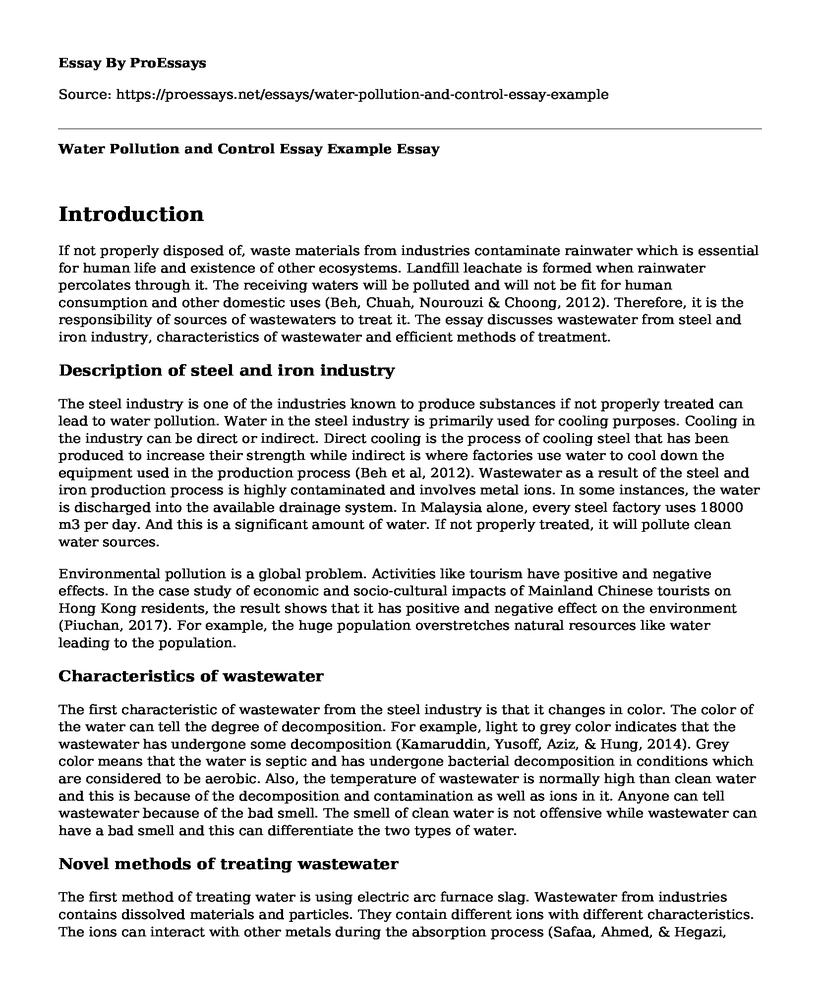Introduction
If not properly disposed of, waste materials from industries contaminate rainwater which is essential for human life and existence of other ecosystems. Landfill leachate is formed when rainwater percolates through it. The receiving waters will be polluted and will not be fit for human consumption and other domestic uses (Beh, Chuah, Nourouzi & Choong, 2012). Therefore, it is the responsibility of sources of wastewaters to treat it. The essay discusses wastewater from steel and iron industry, characteristics of wastewater and efficient methods of treatment.
Description of steel and iron industry
The steel industry is one of the industries known to produce substances if not properly treated can lead to water pollution. Water in the steel industry is primarily used for cooling purposes. Cooling in the industry can be direct or indirect. Direct cooling is the process of cooling steel that has been produced to increase their strength while indirect is where factories use water to cool down the equipment used in the production process (Beh et al, 2012). Wastewater as a result of the steel and iron production process is highly contaminated and involves metal ions. In some instances, the water is discharged into the available drainage system. In Malaysia alone, every steel factory uses 18000 m3 per day. And this is a significant amount of water. If not properly treated, it will pollute clean water sources.
Environmental pollution is a global problem. Activities like tourism have positive and negative effects. In the case study of economic and socio-cultural impacts of Mainland Chinese tourists on Hong Kong residents, the result shows that it has positive and negative effect on the environment (Piuchan, 2017). For example, the huge population overstretches natural resources like water leading to the population.
Characteristics of wastewater
The first characteristic of wastewater from the steel industry is that it changes in color. The color of the water can tell the degree of decomposition. For example, light to grey color indicates that the wastewater has undergone some decomposition (Kamaruddin, Yusoff, Aziz, & Hung, 2014). Grey color means that the water is septic and has undergone bacterial decomposition in conditions which are considered to be aerobic. Also, the temperature of wastewater is normally high than clean water and this is because of the decomposition and contamination as well as ions in it. Anyone can tell wastewater because of the bad smell. The smell of clean water is not offensive while wastewater can have a bad smell and this can differentiate the two types of water.
Novel methods of treating wastewater
The first method of treating water is using electric arc furnace slag. Wastewater from industries contains dissolved materials and particles. They contain different ions with different characteristics. The ions can interact with other metals during the absorption process (Safaa, Ahmed, & Hegazi, 2013). The process removes biochemical oxygen demand and chemical oxygen demand and this reduces the concentration of metals in wastewater.
Another method to treat wastewater is automatic variable filtration. In this technique, downward filter media clean influent of upward flow. The filtered influent clean the filter hence there is no need for additional water hence the technique is highly efficient (Safaa et al, 2013). The cleaned water is reused in the industry thus reducing the discharge of wastewater. The technique is highly efficient in producing clean water for reuse in the steel and iron industry.
The other technique used is biological rotating contactor process. The process involves a large disk containing radial with concentric passages that rotate slowly in a tank of concrete nature. Exposure to oxygen and rotation of waste products create biomass which is a thin layer (Safaa et al, 2013). The result is that the biomass shears off which is then removed. The purpose of this method is to remove dissolved organics.
Conclusion
The growth of various industries has increased the discharge of wastewater. Therefore, it is the responsibility of all stakeholders involved to ensure wastewater treatment. Wastewater treatment methods are electric arc furnace slag, automatic variable filtration, and biological rotating contactor process.
References
Beh, C. Chuah, T. Nourouzi & Choong, T. (2012). Removal of heavy metals from steel makingwaste water by using electric arc furnace. E-Journal of Chemistry 9(4), 2557-2564.
http://downloads.hindawi.com/journals/jchem/2012/128275.pdf
Kamaruddin, M. Yusoff, M. Aziz, H & Hung, Y. (2014). Sustainable treatment of landfillleachate. Applied Water Science 5(2), 113-126. https://link.springer.com/article/10.1007/s13201-014-0177-7
Piuchan, M. (2017). Economic and socio-cultural impacts of mainland Chinese tourists on HongKong residents. Kasetsart Journal of Social Sciences 39(1), 9-14.https://www.sciencedirect.com/science/article/pii/S2452315117306136
Safaa, R. ahmed, A & Hegazi, H. (2013). Treatment of leachate from municipal solid wastelandfill. Housing and Building Research Center Journal 9(2), 187-192. https://www.sciencedirect.com/science/article/pii/S168740481300031X
Cite this page
Water Pollution and Control Essay Example. (2022, Dec 02). Retrieved from https://proessays.net/essays/water-pollution-and-control-essay-example
If you are the original author of this essay and no longer wish to have it published on the ProEssays website, please click below to request its removal:
- Counterfeit Machine Components: Effects and Consequences
- Life Long Learning: Degree in Engineering Essay
- Rebuilt Title Car Isn't Bad Essay Example
- The Methodology of Underwater Concrete Pouring Essay
- Japan Tsunami 2011 Essay Example
- Essay Example on Kuwait: World's Largest Oil Exporter and Its Trade Partners
- Essay Example on MENA Oil: 30 Yrs of Market Transformation & OPEC Rules







